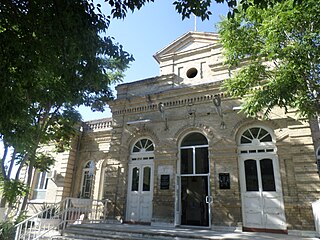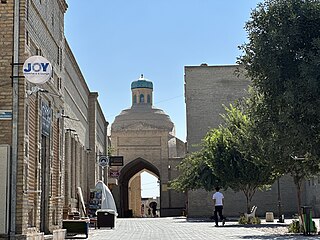18 Sights in Bukhara, Uzbekistan (with Map and Images)
Legend
Premium Sights
Book tickets, guided tours and activities in Bukhara.
Guided Free Walking Tours
Book free guided walking tours in Bukhara.
Welcome to your journey through the most beautiful sights in Bukhara, Uzbekistan! Whether you want to discover the city's historical treasures or experience its modern highlights, you'll find everything your heart desires here. Be inspired by our selection and plan your unforgettable adventure in Bukhara. Dive into the diversity of this fascinating city and discover everything it has to offer.
Sightseeing Tours in BukharaActivities in BukharaChor Minor, alternatively known as the Madrasah of Khalif Niyaz-kul, is a historic gatehouse for a now-destroyed madrasa in the historic city of Bukhara, Uzbekistan. It is located in a lane northeast of the Lyab-i Hauz complex. It is protected as a cultural heritage monument, and also it is a part of the World Heritage Site Historic Centre of Bukhara. In Persian, the name of the monument means "four minarets", referring to the building's four towers.
2. Samanid Mausoleum
The Samanid Mausoleum is a mausoleum located in the northwestern part of Bukhara, Uzbekistan, just outside its historic center. It was built in the 10th century CE as the resting place of the powerful and influential Islamic Samanid dynasty that ruled the Samanid Empire from approximately 900 to 1000. It contained three burials, one of whom is known to have been that of Nasr II.
3. Church of Archangel Michael in Bukhara
The Church of the Archangel Michael is a functioning Orthodox church of the Tashkent and Uzbekistan diocese of the Central Asian Metropolitan District of the Russian Orthodox Church, located in the city of Bukhara.
4. Mousoleum Chasma Ayub
Chashma-Ayub Mausoleum is located near the Samani Mausoleum, in Bukhara, Uzbekistan. Its name means Job's well, due to the legend in which Job (Ayub) visited this place and made a well by striking the ground with his staff. The water of this well is still pure and is considered healing. The current building was constructed during the reign of Timur and features a Khwarazm-style conical dome uncommon in Bukhara.
5. Khanqah of Nodir Devonbegi
Nodir Devonbegi is a historical memorial in Bukhara, Uzbekistan. It was established by Nodir Devonbegi, the vizier and brother of the ruler of Bukhara, Imamquli Khan, in 1620–1621. The Khanaka has been included in the national list of intangible cultural heritage objects of Uzbekistan.
6. Namozgoh
The Bukhara Mosque is a historical monument in Bukhara. It is one of the mosques built for praying during Eid festivals. It was built behind the gate of the prayer hall in the southern part of Bukhara by Shams al-Mulk (1068-1080), who ruled Bukhara under the Kara-Khanid dynasty, in the 11th century. It was built in the 11th-16th centuries.
7. Magoki Kurpa Mosque
The Magok-i-Kurpa Mosque is a historical mosque in the Uzbek city of Bukhara. It was built in 1637. The mosque is located in the historical center of Bukhara, about 250 meters southwest of Po-i-Kalyan and 10 meters west of Toqi Telpak Furushon trading dome. It is a part of UNESCO World Heritage Site Historic Centre of Bukhara.
8. Toki Zargaron
Toqi zargaron — Buxorodagi meʼmoriy yodgorlik va zargarlik buyumlari sotish uchun moʻljallangan savdo markazi biri boʻlgan. Mazkur meʼmoriy yodgorlik Shayboniy hukmdor Abdullaxon II davrida 1582-yilda bunyod etilgan. Hozirgi kunda Oʻzbekiston moddiy va madaniy meʼrosining koʻchmas mulk obyektlari milliy roʻyxatiga kiritilgan.
9. Khalifa Hudoidod Cathedral Mosque
The Xalfa Xudoydod Complex is an architectural monument in Bukhara Region, Uzbekistan. The complex was built by Sheikh Xudoydod ibn Toshmuhammad Azizon al-Bukhari in 1777–1855, during the reign of the Manghit dynasty in Bukhara Emirate. The complex consists of a madrasa, a mosque, a house, a cistern and a cemetery.
10. Darvozai Sallohhona
The Gate of Salakhon (Salohhon) is a gateway recreated at the former site in Bukhara (Uzbekistan). The first time was erected in the second half of the 16th century, under the Uzbek ruler Abdullah Khan II, in the then capital of the Bukhara Khanate. It was installed on the south-eastern part of the Bukhara Fortress Wall. "The town was connected to the nearby villages, ""the movement through them was relatively small.""" "The demolition, with the adjacent urban wall, under the Soviet power on 17 May 1939, was ""destructing normal movement in the city.""" Recreated 2012. They are among the four recreated pre-destructed and 11 ever existing gates of Bukhara. They are on the street. A. Took mahalli to them. Hamid Alimjan.
11. Zindon

Bukhara Prison is a fortified building that traditionally served as the prison of the Amir of Bukhara, in Uzbekistan. In the late 18th century, during the reign of the Mangits, it was built and was one of the largest prisons of the Bukhara Emirate. After the Bukhara Revolution, the collapse of the monarchy, and the formation of the Bukhara People's Soviet Republic, it was closed. Currently, it is considered one of the noteworthy places in the city. At the same time, the Museum of Legal and Judicial History of Bukhara is located here.
12. Balyand Mosque
Baland Mosque, which means the "upper mosque", is a historical mosque in the ancient city of Bukhara, Uzbekistan. Registered as a World Heritage Site by UNESCO along with the whole of the historic old town, this small mosque was built at the beginning of the 16th century in the southern part of the city.
13. Govkushon majmuasi
The Khoja-Gaukushan Ensemble is one of the largest architectural complexes in the center of Bukhara. Along with a number of other buildings in central Bukhara, it is included in the UNESCO World Heritage List.
14. Rashid Madrasah
Rashid madrasah is a two-story madrasah building located in the historical center of the city of Bukhara, Bukhara Region, Republic of Uzbekistan. It is included in the national list of real estate objects of material and cultural heritage of Uzbekistan.
15. Toqi Sarrofon
Toqi Sarrofon is an architectural monument and one of the main trade centers for money exchange in Bukhara. This architectural monument was built in 1534-1535 by the order of the Shaybanid ruler Ubaydullah Khan. It is currently included in the national register of immovable property of the material and cultural heritage of Uzbekistan.
16. Magʻoki Attori masjidi
Magʻoki attori masjidi — oʻrta asr meʼmorchiligi yodgorligi, Buxorodagi tarixiy, 12—16-asrlarga oid ustunli gumbazli masjid. Yer sathidan 4,5 metrdan koʻproq pastda joylashgan. Oʻymakor bezaklari bilan mashhur. Buxoro yodgorliklarining bugungi kungacha saqlanib qolganlar orasidagi eng qadimiysi. Magʻokda (chuqurlikda) hamda attor bozorlari yaqinida joylashgani sababli Magʻoki attori masjidi deb nomlangan.
17. Toki Telpakfurushon
Toki Telpakfurushon is a traditional covered bazaar in the historical center of Bukhara, Uzbekistan. It was built in the XVI century, more precisely in 1570-1571, during the formal reign of Iskander Khan from the Uzbek Shaybanid dynasty. The actual ruler of the Bukhara Khanate at that time was his son, Abdullah Khan II.
18. Xo'ja Zayniddin majmuasi
Xoʻja Zayniddin majmuasi — Buxorodagi meʼmoriy yodgorlik ; Buxoro xonligining Shayboniylar sulolasi davrida Zayniddin tashabbusi bilan Imom al-Buxoriy sharafiga usta Mir Doʻstumbiy tomonidan bunyod etilgan tarixiy yodgorlik. Majmua Xoʻja Zayniddin guzarida, shahristonning janubi-gʻarbiy qismida joylashgan. Xoʻja Zayniddin majmuasi masjid xonaqosi, hovuz, maktabxona, binosoz mozori va ziyoratchilar uchun hujralar mavjud. Hozirgi kunda majmua Oʻzbekiston moddiy va madaniy meʼrosining koʻchmas mulk obyektlari milliy roʻyxatiga kiritilgan.
Share
How likely are you to recommend us?
Disclaimer Please be aware of your surroundings and do not enter private property. We are not liable for any damages that occur during the tours.
















